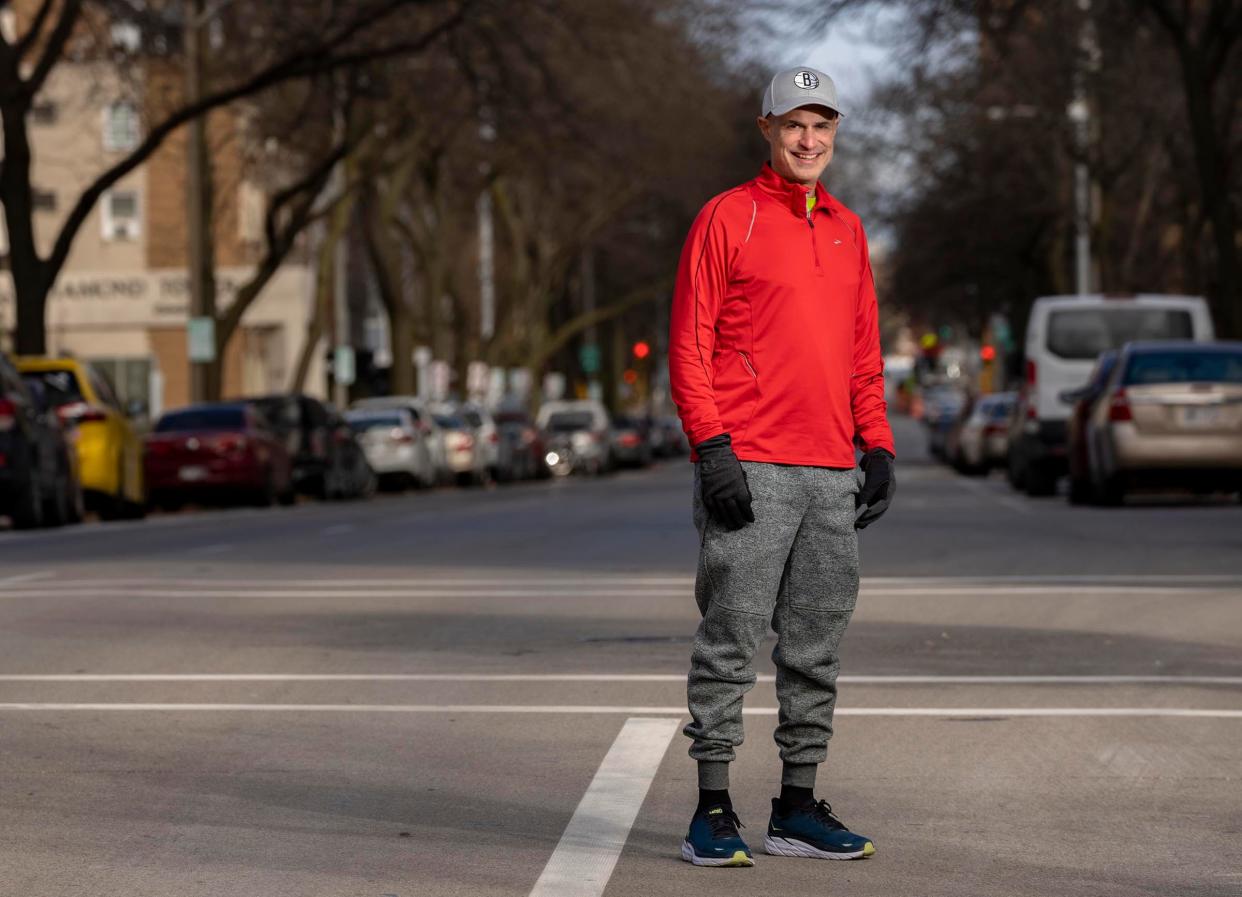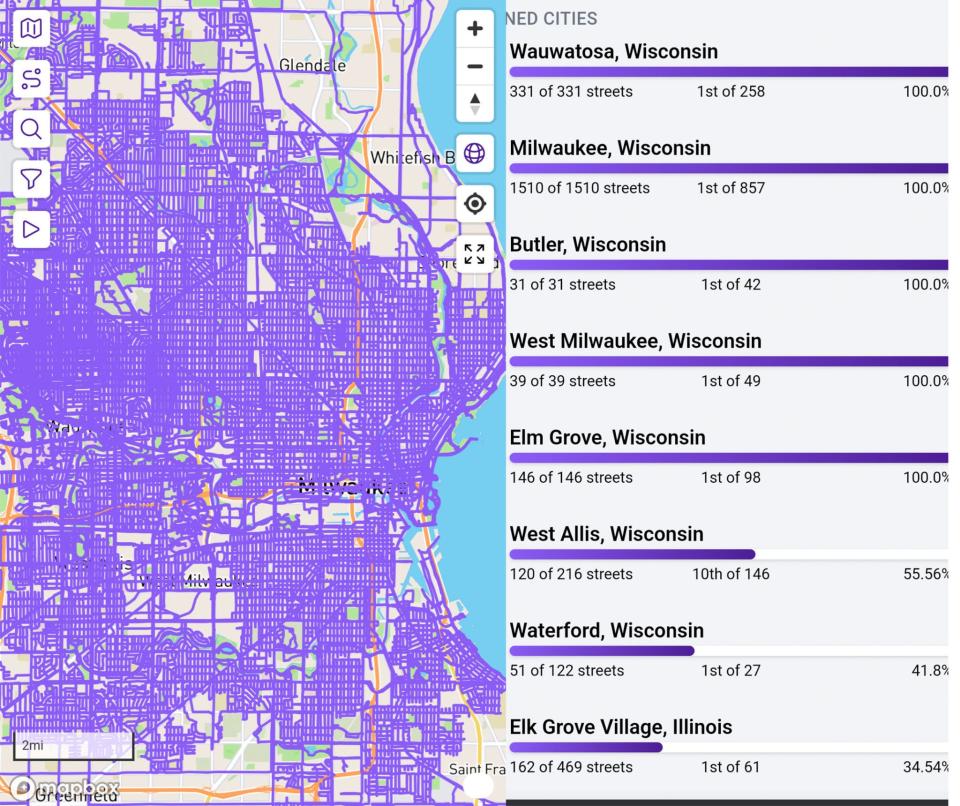This man ran every single street in Milwaukee. Here's what he discovered.

One morning in July, Chris Ponteri's running route included the six lanes where cars line up for the Lake Express Ferry in Milwaukee. But when he got there, he discovered a problem: The lanes were locked away from the general public.
Another runner would adjust his route — who wants to run in a car lane anyway? — and move on. But Ponteri, 56, had made it a mission to run every street in the City of Milwaukee. And technically, at least according to CityStrides software, those lanes are city streets.
"I had to go into the building where people were working and go out the back door," Ponteri said. "Two of the employees followed me out and asked what I was doing. When I told them, they thought it was the coolest thing."
From the lakefront to the zoo, from areas bordering Mequon to areas bordering Oak Creek, Ponteri spent the past year and a half trying to navigate every single street. He ran through alleys on the northwest side that count as streets, coasted past a tapestry of architecture and even negotiated the "streets" for rental car returns and parking around the airport.
On Nov. 17, the journey came to an end. His final 22-mile run checked off a few segments of 8th Street and 7th Street and then completed the project with a block of E. Curtis Place between Prospect and Farwell.
"Part of me doesn't even feel like it's sunk in that I finished it all, but it is a great sense of accomplishment; for a year I thought about that (final) day," Ponteri said. "I definitely like to do things to the extreme. I didn't do it for the attention or anything, I just did it because I wanted to.
"It'll probably be a little harder to get motivated now that I've finished it, but I'll just move on to West Allis. I've got 55% of West Allis done, and I have a lot of Brookfield left to do."
So why run every street of Milwaukee?

Needless to say, running is a big part of life for Ponteri, a financial advisor who moved to Wauwatosa two years ago and previously lived in Wind Lake. He's lost track of the number of competitive marathons he's completed (near 50), and he was the driving force behind the Milwaukee Marathon, but he doesn't run competitively much anymore. He's simply discovered a love for neighborhood runs, which helped him log 4,000 miles last year and between 3,000-3,500 this year.
"Things are more interesting in neighborhoods," Ponteri said. "You see a lot of unusual things: people, signs, cars, buildings, all the neighborhoods seem to have their own character."
This isn't the first city he's conquered, just the biggest. Logging all of his runs in CityStrides and occasionally tackling long runs with his buddies, he'd already mastered Wauwatosa and Elm Grove when he started thinking about Milwaukee.
"I run six times a week and maybe two of them were Milwaukee runs," he said. "Otherwise I'd run West Allis or stick around (Wauwatosa), so I wasn't doing every run (in Milwaukee)."
With nearly 1,700 miles of Milwaukee streets, the project required planning.
How does someone chart all the streets of Milwaukee?
Milwaukee, every block, every street. ✅🏃♂️🎖️ pic.twitter.com/tg8lR79JdZ
— Chris in Tosa (@chrisptosa) November 17, 2022
Ponteri spent a lot of time mapping his runs in advance, with the challenge increasing as he had fewer and fewer spots to cover. He'd physically write directions on small pieces of paper as he set out so he knew where to turn.
"For some of the longer runs, I'd fill up two or three pieces of paper," he said. "It was kind of a logistical difficulty when it was raining or when it was hot and my hands were getting all sweaty. Once in a while, I'd lose my sheet of paper and not even realize it, so I'd take pictures with my phone in case I did."
Once he was more than halfway through the Milwaukee streets, he built a spreadsheet that listed the roads still to conquer and their neighborhoods to more easily plot routes.
The runs ranged from three to 35 miles. And while occasionally he drove to locations to ease the efficiency of the goal, more often than not he was leaving on foot from his home. On weekends, it was common for him to do a marathon's worth of running.
"Twenty-six miles can get you to almost any part of the city," he said. "But I did drive and park somewhere and do a 10- to 12-mile run from there towards the end. That was the only way I could get some of these neighborhoods. My friends (jokingly) look down on me for driving once in a while, but whatever, I ran every street and they're going to be stuck at 60% (of Milwaukee completed) forever."
One of the bigger challenges was the jagged movement of the city's border.
"I can't imagine back in the 1930s what they were thinking when they were negotiating who got what streets," he said. "'We'll give you 61st if you give me 62nd' kind of thing. It was a challenge just staying in Milwaukee."
Is it dangerous to navigate a major city's streets?
Sure, there are some tricky intersections here and there, but Ponteri bristles against the idea that the city might be dangerous for pedestrians.
"Anybody who disagrees with me has never lived in some of the far suburbs like I did where there are no streetlights, no sidewalks, very few stoplights, busy roads and you're running at your own risk," Ponteri said. "I think Milwaukee is much more dangerous for drivers."
Then, there's the perception of "bad neighborhoods" that Ponteri also dismisses.
"It isn't nearly as bad as people think. People just kind of leave you alone if you're running, but even if I wasn't running, I don't think there'd be any danger. The biggest danger is the reckless driving."
Ponteri said he did witness a joyrider crash into a playground basketball hoop and saw a group of what he believed were stolen cars, but he said the people he encountered often met him with smiles.
"Some of these neighborhoods that are really challenged neighborhoods, the people there are so encouraging," Ponteri said. "For every mile you're there, two or three people are cheering you on, which would never happen in Brookfield. Not that people aren't friendly there, you just get a lot of encouragement, people honking horns. It's one of those things you have to experience to see."
Ponteri said he once had to climb a fence to get through his route, and has occasionally cut through people's yards or between apartment buildings to access roads, but that was as big a roadblock as he faced — outside of the locked car-ferry lot.
What are the best places to run in Milwaukee?
Ponteri's favorite spot was the Wedgewood Park neighborhood on the city's southwest side.
"The houses are very unusual; they all have carports, mid-century modern looking, and a lot of the streets have the feel of an alley. They're all angled streets, with sidewalks through backyards of the houses. The neighborhood was designed like this to be a real pedestrian-friendly neighborhood."
Other spots he enjoys are the Enderis Park neighborhood and Roosevelt Grove on the city's north side; the latter is full of beautiful, well-kept houses. He likes Walker's Point, Jackson Park and the Valley Park neighborhood known as "Pigsville" near American Family Field.
"I think urban running is very underrated," Ponteri said. "You can find heat maps (online), and it shows where people are running. Down by the lakefront is real bright, and Tosa on the parkway is bright, but there is no brightness in these (other) neighborhoods at all, nobody is running in them. I don't think people even run in their own neighborhoods that much; they go right to the parkway or something. Nothing that really compares to running in neighborhoods."
JR Radcliffe can be reached at (262) 361-9141 or jradcliffe@gannett.com. Follow him on Twitter at @JRRadcliffe.
This article originally appeared on Milwaukee Journal Sentinel: Chris Ponteri ran every street in Milwaukee. Here's what he learned.

